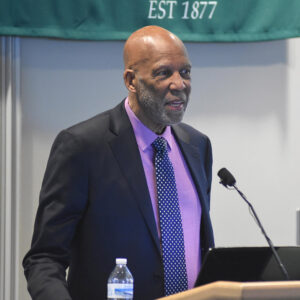calsfoundation@cals.org
Terrence James Roberts (1941–)
Terrence James Roberts made history as a member of the Little Rock Nine, the nine African-American students who desegregated Little Rock Central High School in 1957. The world watched as they braved constant intimidation and threats from those who opposed integration of the formerly all-white high school.
Terrence Roberts, the eldest of seven children, was born on December 3, 1941, in Little Rock (Pulaski County) to William and Margaret Roberts. His father was a World War II naval veteran who worked at the Veteran’s Administration (VA) hospital in North Little Rock (Pulaski County), and his mother ran a catering service from home.
Roberts was a sophomore at Horace Mann High School when he volunteered to integrate Little Rock’s Central High School for the 1957–58 school year. Despite daily harassment from some white students, Roberts completed his junior year at Central. The following year, the city’s high schools were closed to prevent further desegregation. As a result, Roberts moved to Los Angeles, California, and graduated from Los Angeles High School in 1959.
Following his graduation from high school, Roberts attended California State University at Los Angeles and earned a BA in sociology in 1967. He attended graduate school at the University of California at Los Angeles and received an MS in social welfare in 1970. In 1976, Roberts earned a PhD in psychology from Southern Illinois University in Carbondale. He served as co-chair of the department of Master of Arts in Psychology Program at Antioch College in Los Angeles, California, and also taught several graduate courses there. In addition to serving as CEO of Terrence J. Roberts and Associates Management Consulting Firm, he maintains a private psychology practice and is a desegregation consultant to the Little Rock School District.
On May 17, 1979, Roberts was able to meet Orval Faubus face to face on ABC’s Good Morning, America. He said, “I really feel it was a violation of public trust to practice your own personal policies of racism in that position. You endangered not only my life, but the lives of hundreds of other people, both black and white.”
Roberts was awarded the prestigious Spingarn Medal by the National Association for the Advancement of Colored People (NAACP) in 1958. In 1999, President Bill Clinton presented the nation’s highest civilian award, the Congressional Gold Medal, to the members of the Little Rock Nine.
In 2009, he published a memoir, Lessons from Little Rock. The following year, he published Simple Not Easy: Reflections on Community Social Responsibility and Tolerance.
For additional information:
Bates, Daisy. The Long Shadow of Little Rock. Fayetteville: University of Arkansas Press, 1986.
Beals, Melba Pattillo. Warriors Don’t Cry: A Searing Memoir of the Battle to Desegregate Little Rock’s Central High School. New York: Washington Square Books, 1994.
Jacoway, Elizabeth, and C. Fred Williams, eds. Understanding the Little Rock Crisis: An Exercise in Remembrance and Reconciliation. Fayetteville: University of Arkansas Press, 1999.
Little Rock Central High School National Historic Site Visitor Center. Little Rock, Arkansas. http://www.nps.gov/chsc/ (accessed July 11, 2023).
Roberts, Terrence. Lessons from Little Rock. Little Rock: Butler Center Books, 2009.
———. Simple Not Easy: Reflections on Community Social Responsibility and Tolerance. Little Rock: Parkhurst Brothers, 2010.
Roy, Beth. Bitters in the Honey: Tales of Hope and Disappointment across Divides of Race and Time. Fayetteville: University of Arkansas Press, 1999.
Terrence Roberts Papers. Butler Center for Arkansas Studies. Central Arkansas Library System, Little Rock, Arkansas.
National Park Service
Central High School National Historic Site
 Civil Rights Movement (Twentieth Century)
Civil Rights Movement (Twentieth Century) Education, Elementary and Secondary
Education, Elementary and Secondary World War II through the Faubus Era, 1941 through 1967
World War II through the Faubus Era, 1941 through 1967 Little Rock Nine Thanksgiving
Little Rock Nine Thanksgiving  Mays, Roberts, Trickey
Mays, Roberts, Trickey  Roberts Book Signing
Roberts Book Signing  Roberts Marker
Roberts Marker  Terrence Roberts
Terrence Roberts  Terrence J. Roberts
Terrence J. Roberts 




Comments
No comments on this entry yet.